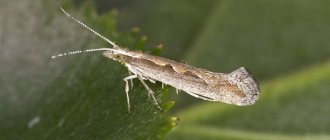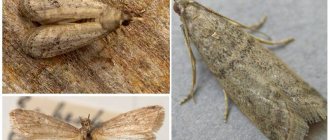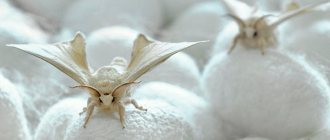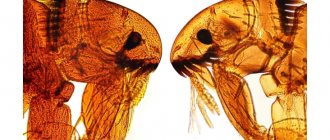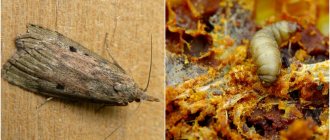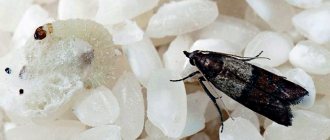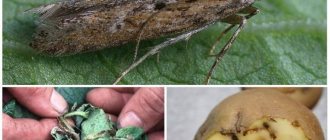The wax moth, or moth, is an inconspicuous butterfly, small in size and modest in color, but has gained fame as a formidable enemy of beekeeping.
The immediate danger to people who breed bees is not the butterflies themselves, but the moth larvae that infect the hives in search of food. Small caterpillars harm beekeepers by eating honeycombs and other products produced by bees.
However, wax moths can provide significant benefits. Based on the caterpillars, medicines are produced that have almost unique medicinal properties.
However, the cultivation of caterpillars is carried out more often in large beekeeping farms; smaller apiaries consider the moths exclusively as parasites, using all available methods and methods to combat them, which we will discuss in more detail later.
Ways to combat wax moths
How to deal with wax moths when a pest appears?
There are a lot of different methods that can be divided into three main groups: biological, chemical, mechanical. The choice of the most suitable one is carried out by determining the degree of infection, the number of honeycombs affected by the moth, and a number of other factors.
It should be noted that bees are quite capable of independently protecting the hive from pest invasion and damage. When the caterpillars penetrate, the insects literally seal the larva, which leads to the death of the latter. It is for this reason that it is extremely important to provide the bees with access to all the nooks and crannies of the hive. However, it is important to remember that bees can only cope with a small number of parasites.
Biological method
So how do you get rid of wax moths in your hive? Beekeepers do not recommend using chemicals to neutralize pests when the number of pests is small. To prevent the appearance of moths, when a small number of pests appear, you can use biological methods, that is, involving the use of products of natural origin.
The leaves of immortelle, mint, and walnut perfectly repel parasites. To eliminate wax moths and prevent their appearance, you need to carefully pour frames prepared for long-term storage.
An excellent remedy for parasites is mint tincture. To kill insects, just mix it with a small amount of water, then pour it between the frames and place it for a day to dry. This product is not harmful to bees. As a rule, the use of these products causes butterflies to settle further away from the treated areas.
Mechanical method
But what to do if moths appear in the hives, but the use of biological and chemical agents is not possible for a number of reasons? In such a situation, it is sufficient to use a mechanical method, which involves shaking the larvae out of the frames manually. In order for the pests to leave the shelter, it is enough to lightly knock on the frame and then shake out the insects.
Available and special chemicals
Before fighting wax moths, it is recommended to carefully study the methods, methods, and means that will help you do this quickly, effectively, and safely for bees. It is best, of course, to use organic means, but with a severe degree of infection, the use of tablets and chemicals may be required.
Salt treatment
The fight against wax moths includes mandatory processing of frames immediately before sending them to the honeycomb storage facility. The easiest way is to use a saturated solution of common salt. After preparing such a product, it is enough to pour the resulting concentrate into a spray bottle, and then carefully treat the potential affected areas. After drying, a white layer forms on the frames, which has a repellent effect on wax moths. This measure will help to effectively protect the dry body from the invasion of moths.
Fumigation
In case of severe damage, you can get rid of parasites on the frames by using ordinary sulfur dioxide. To destroy the parasite, it is necessary to fumigate the frames twice over three weeks at regular intervals; this, of course, should be done before sending the honeycombs to dry. When thinking about how to remove wax moths from a hive, one should not forget about the benefits of these caterpillars. If there are enough parasites, it is quite possible to prepare a useful tincture based on them.
Freezing and heating
As with any other pest, control methods aimed at destroying wax moths include exposure to high or low temperatures. You should know that wax moths die at temperatures below ten degrees.
In order to get rid of parasites, you can take the frames outside in the winter or place them in the refrigerator. To eliminate the possibility of parasite survival, it is recommended to carry out the procedure for at least two hours. Heat treatment involves the use of high temperatures of over fifty degrees.
Vapors of acetic or formic acid
The easiest way to protect honeycombs from wax moths is to treat the frames with formic or acetic acid.
To remove fireflies, simply place a small container with the selected product at the bottom of the box, then cover it on top with a thin layer of polyethylene. It is recommended to periodically check the amount of product, replenishing it if necessary.
Traditional methods
To get rid of wax moths in hives, it is recommended to use various traditional methods. Knowing what parasites are afraid of, you can quickly achieve good results. For example, to prevent females from leaving clutches of eggs, it is recommended to leave several containers on the site, at the bottom of which pour water mixed with sugar and honey. Despite the fact that adult butterflies do not need food, they fly to a pleasant smell.
Ordinary naphthalene will help get rid of parasites. The given substance should be placed directly in the hives using small boxes. To prevent a number of unpleasant consequences, it is recommended to remove these boxes during the main honey collection period.
To remove pests, you can use scented sachet-type pads. To make them, you need to sew gauze into a pillow shape, pre-folded in several layers. Next, you need to place in these improvised pillows any plant that has a distinct specific smell, for example, mint, wormwood, geranium. Place the bags in the room where the dry goods are stored.
To quickly remove parasites, it is recommended to treat hives or honeycomb storage rooms with smoke. In order to obtain it for subsequent fumigation of infected honeycombs, it is necessary to set fire to combustible sulfur.
It is important to use this method with some caution.
It should be noted that if honeycombs are heavily infested, the use of traditional methods may not be effective. To remove large numbers of wax moth larvae, it may be necessary to use strong insecticides.
Preventive measures
To prevent wax moth infection, the following recommendations should be followed:
- provide conditions for the creation of strong bee colonies;
- maintain order and cleanliness in the hive, honeycomb storage and apiary;
- keep bee hives in neat and good condition;
- maintain the temperature in the cell storage facility below +10°C and ensure good ventilation and dry air;
- fumigate the honeycomb storage facility with sulfur (50 g per 1 m³) for 24 hours, repeat the procedure after two weeks;
- a third of the honeycombs should be replaced annually with newly rebuilt ones;
- place grooves with water around the hive to prevent larvae from crawling between hives;
- store wax in tightly closed containers;
- When using tick traps, clean the pallets regularly and burn the waste;
- It is advisable to pack stored beekeeping material in transparent polyethylene in order to notice the appearance of moths in time;
- Damaged cells must be destroyed.
Important! Do not treat with sulfur if there is honey in the combs, as sulfur compounds can harm bees.
The best protection against wax moths is prevention of infestation. Timely detection of the pest and breeding strong and resilient bee colonies capable of independently fighting insect pests will allow you to effectively cope with a possible threat.
Protecting sushi during storage
One of the most common issues that worries almost every beekeeper is the preservation of land from wax moths. To protect frames during storage, it is recommended to periodically check them for the presence of pests, removing them if necessary. The room where dry goods are stored must be well ventilated.
To repel larvae and adult butterflies, it is recommended to use various plants that have a distinct odor, such as peppermint. The stems should be laid out on the bottom of the boxes, on the floor around the frames. You can use ordinary garlic instead of mint, after cutting several cloves into large pieces.
There are quite effective chemical agents that will also help to quickly repel moths.
Products of this kind are plates that are completely harmless to bees, but destructive to wax moths. Such plates should be placed strictly between the frames. They should be changed as needed.
How to prevent caterpillars from appearing?
It is better to prevent a problem than to fight it. To achieve this, experienced beekeepers carry out a number of preventive measures.
First, you need to keep your hives clean. Secondly, as soon as you notice that wax moths have appeared in the hive, you need to start fighting this pest and not delay it. Thirdly, timely repair of hives and frames. Fourthly, wax should be stored as far as possible from the hives and try to be recycled immediately. Fifth, store additional honeycombs in a well-ventilated area and constantly inspect them.
Experienced beekeepers try to plant plants next to the hives that repel wax moths. It could be:
- mint;
- marigold;
- Melissa;
- sagebrush.
You can make traps to confuse the moths. A specially prepared mixture is poured into small plates: yeast, honey and a little bee bread.
Signs of bee moth infection
To protect bees and bee products from pest invasion, you need to pay attention to the first signs of wax moths appearing in honeycombs. Factors such as the appearance of thin cobwebs and damage to honeycombs can indicate infection of hives. However, the level of damage may vary depending on the number of parasites.
In the initial stages of formation, pests eat exclusively bee bread and honey. Subsequently, the diet of insects expands significantly; wax, insulation, and other products produced by bees are used. As the larvae grow, they diligently make passages in the walls of the honeycombs, thereby rendering them unusable.
Causes of hive damage
There are several main reasons for the appearance of pests in storage facilities and hives. Especially often, parasites infect old hives that have a large number of cracks and gaps in which female wax moths can lay eggs without hindrance. Insects are also attracted by the lack of necessary cleanliness. The presence of wax or other bee products at the bottom of the hive can be considered by wax moth larvae as an invitation card.
The larvae can move quite freely between hives. It is this ability that simply explains such a high level of prevalence of parasites. The absence of protective grooves between bee houses and plants that insects are afraid of leads to the rapid spread of wax moths.
